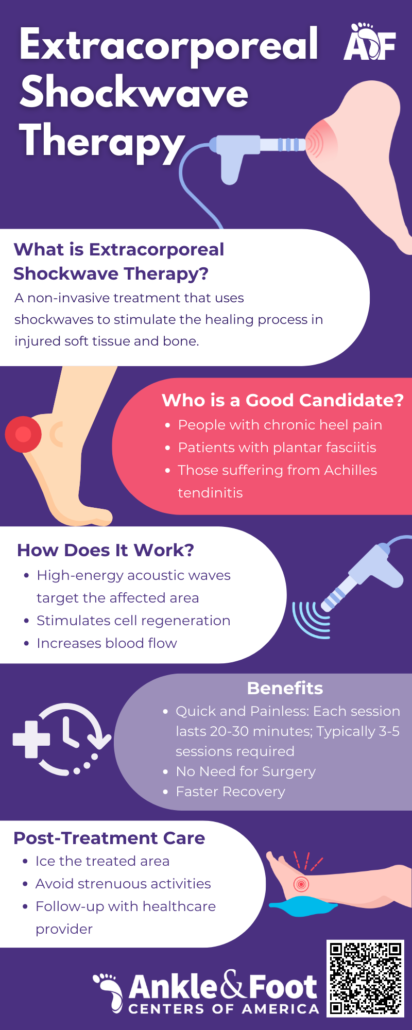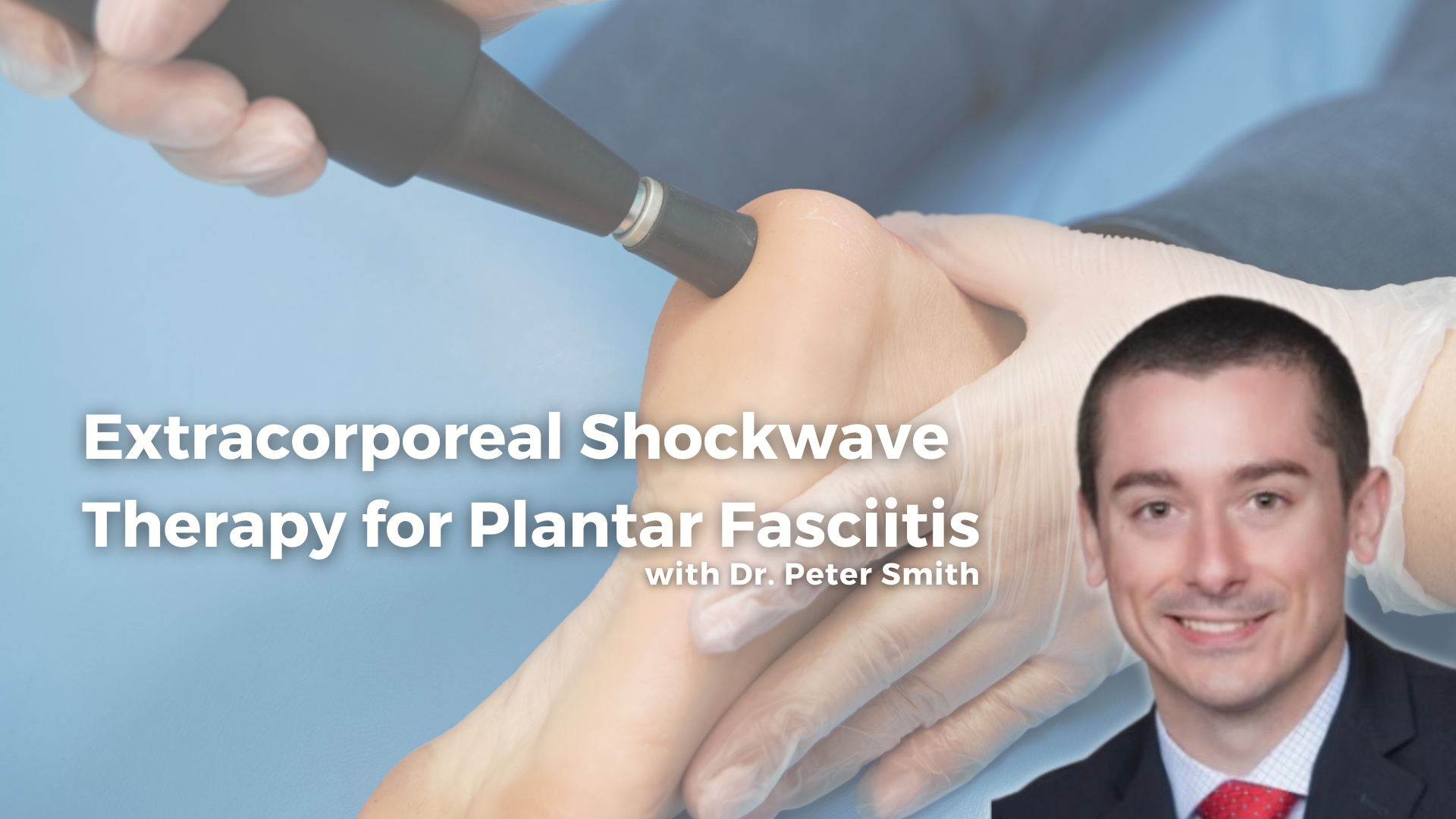Are you familiar with that nagging heel pain that greets you every morning or after a long day on your feet? Yep, we’re talking about Plantar Fasciitis. It’s that pesky condition that makes you wince with every step and has you googling “how to relieve heel pain” at 2 am.
Now, before we dive deep, let’s get a bit of a refresher. Plantar Fasciitis is the inflammation of the plantar fascia, a thick band of tissue that runs across the bottom of your foot, connecting your heel bone to your toes. It’s one of the most common causes of heel pain and can be a real party pooper, especially if you love being active.
But here’s the good news: There’s a superhero treatment in town, and it’s called Extracorporeal Shockwave Therapy. No, it’s not the latest Marvel movie, but it’s just as exciting (well, for us foot nerds, at least). Shockwave Therapy is making waves (pun intended) in the podiatry world as a promising treatment for Plantar Fasciitis. And today, we’re here to give you the lowdown on this innovative procedure.
So, lace up those comfy slippers, grab a cup of tea, and let’s journey together into the world of Shockwave Therapy. Trust us; your feet will thank you!
Table of Contents
What is Extracorporeal Shockwave Therapy? Riding the Waves to Relief
Hey, remember those sci-fi movies where they use futuristic tech to heal injuries? Well, Shockwave Therapy to treat heel pain might sound like it’s straight out of a Star Trek episode, but it’s very much a reality in today’s world of podiatry. And the best part? It’s here to offer relief to all you Plantar Fasciitis warriors.
So, What’s the Buzz All About?
 Shockwave Therapy, also known as Extracorporeal Shock Wave Therapy (ESWT), is a non-invasive treatment that uses high-energy sound waves to kickstart your body’s natural healing process. Think of it as a wake-up call for your cells, urging them to get to work and repair the inflamed tissue in your foot.
Shockwave Therapy, also known as Extracorporeal Shock Wave Therapy (ESWT), is a non-invasive treatment that uses high-energy sound waves to kickstart your body’s natural healing process. Think of it as a wake-up call for your cells, urging them to get to work and repair the inflamed tissue in your foot.
The Science-y Bit (Don’t Worry, We’ll Keep It Simple)
When these shockwaves are applied to the affected area, they increase blood flow, stimulate cell regeneration, and essentially speed up the healing process. It’s like giving your foot a pep talk, encouraging it to heal faster and get back to its pain-free self.
But How Does It Feel?
If you’re imagining a scene from Frankenstein with electric shocks and all, take a deep breath and relax. The procedure is relatively painless. You might feel a bit of discomfort, but it’s a far cry from the sharp pain of Plantar Fasciitis. Many patients describe it as a series of rapid pulses against the skin. And the best part? Each session is quick, usually lasting just a few minutes.
Is It Just for Plantar Fasciitis?
While we’re singing praises for its effectiveness against Plantar Fasciitis, Shockwave Therapy isn’t a one-trick pony. It’s also used to treat other musculoskeletal conditions like Achilles tendonitis and tennis elbow. But for now, let’s focus on its magic for those pesky heel pains.
The Perks of Shockwave Therapy: Why Your Feet Might Just Throw a Party
Alright, so we’ve chatted about what Shockwave Therapy is and had a brief science lesson (without the boring bits). Now, let’s get to the juicy part: Why is Shockwave Therapy becoming the talk of the town in the world of heel pain solutions?

Non-Invasive is the Name of the Game
First things first, no one likes the idea of going under the knife. And with Shockwave Therapy, you won’t have to. This treatment is non-invasive, meaning there are no incisions, no anesthesia (for most patients), and no long recovery times. It’s like getting a deep tissue massage for your foot, just with some high-tech sound waves doing the magic.
Quick and Efficient
We live in a fast-paced world, and spending hours at the doctor’s office isn’t on anyone’s wish list. The beauty of Shockwave Therapy? Each session is quick, often wrapping up in just about 10 minutes. So, you can pop in during your lunch break and be back in time for that afternoon meeting depending on which level of service you opt for. In some cases, anesthesia might be used when the case of plantar fasciitis is more server.
Natural Healing Boost
Your body is pretty amazing at healing itself. Sometimes, it just needs a little nudge in the right direction. Shockwave Therapy does just that. By stimulating blood flow and cellular activity, it encourages your body to heal naturally, without relying on medications or other interventions.
Long-Term Relief
While quick fixes can be tempting, we’re all in for treatments that offer lasting relief. And guess what? Many patients report significant pain reduction and improved functionality after just a few sessions of Shockwave Therapy. It’s not just about masking the pain; it’s about addressing the root cause.
Safe and Sound (Wave)
Safety first, always. One of the standout features of Shockwave Therapy is its safety profile. Since it’s non-invasive and doesn’t rely on drugs, the risk of side effects is minimal. Of course, always chat with your podiatrist to ensure it’s the right fit for you.
Shockwave Therapy in Action: A Journey to Heel Happiness
Alright, foot pain sufferers (and those just tired of plantar fasciitis), let’s get down to the details. You’ve heard about the wonders of Shockwave Therapy, but what’s it like to actually experience it? Let’s walk (pain-free, of course) through the process together.
The Initial Consultation: Getting to Know You and Your Feet
Before diving into the treatment, your podiatrist will want to have a chat. This is where you discuss your symptoms, how long you’ve been experiencing pain, and any other relevant medical history. It’s a bit like a first date, just with your foot as the main topic of conversation.
The Setup: No, It’s Not a Sci-Fi Movie Set
Once you’re all set for the treatment, you’ll be comfortably positioned, and the affected foot will be prepped. The podiatrist might apply a gel to the heel area to help the shockwave device glide smoothly. The machine itself looks a bit futuristic, but don’t worry, it’s friendly.
The Treatment: Riding the Waves
Here comes the main event. The podiatrist will place the shockwave device on the affected area and start the treatment. You’ll feel a pulsing sensation, a bit like tiny hammers tapping on your foot. It might be a tad uncomfortable, but it’s usually not painful. And remember, it’s super quick!
Post-Treatment: Walking on Cloud Nine
Once the session is over, the gel will be wiped off, and you’re good to go! You might feel a bit of tenderness or warmth in the treated area, but that’s just your body getting to work on the healing process. Most people can walk out of the clinic and go about their day as usual.
The Follow-Up: Keeping in Touch
Your journey doesn’t end with just one session. Depending on the severity of your Plantar Fasciitis, you might need a few sessions to feel the full benefits. Your podiatrist will schedule follow-up appointments to monitor your progress and ensure you’re on the path to heel happiness.
And there you have it, a behind-the-scenes look at Shockwave Therapy. It’s a blend of science, technology, and a sprinkle of magic (okay, maybe not magic, but it sure feels like it).

Your Burning Questions Answered: Shockwave Therapy FAQ
We get it. When it comes to your feet, you want to be in the know. And while Shockwave Therapy sounds promising, you’ve got questions. Don’t worry; we’ve got the answers. Let’s dive into some of the most frequently asked questions about this revolutionary treatment.
Why do I need shockwave therapy?
Great question! Plantar Fasciitis can be a stubborn condition. While traditional treatments like stretches, orthotics, and activity modifications can help, some cases need an extra push. Shockwave Therapy provides that push by stimulating your body’s natural healing processes, targeting the root cause of the pain.
What precautions should I take after shockwave therapy?
Post-treatment, it’s essential to give your foot some TLC. While you can usually walk and go about your day, it’s a good idea to avoid strenuous activities for a couple of days. Think of it as a mini-vacation for your foot. Also, if you feel any discomfort, icing the area can help.
What can I expect after the therapy session?
Immediately after the session, you might feel a bit of warmth or tenderness in the treated area. This is normal and a sign that the therapy is working its magic. Over the next few days, as the healing process kicks in, many patients report a gradual reduction in pain and improved foot function.
How long does it take to see results?
While some lucky folks feel relief after just one session, most people need a few sessions to experience the full benefits. The healing process is gradual, and the results can vary from person to person. But patience is key; your feet are on their way to feeling fabulous!
Can I walk immediately after shockwave therapy?
Absolutely! One of the perks of Shockwave Therapy is that there’s no downtime. You can walk out of the clinic and resume most of your regular activities. Just remember to take it easy and avoid any high-impact exercises for a day or two.
How effective is shockwave therapy for plantar fasciitis?
 Shockwave therapy, or Extracorporeal Shock Wave Therapy (ESWT), has emerged as a promising treatment for plantar fasciitis, especially for cases resistant to traditional methods. The therapy uses high-energy sound waves to stimulate blood flow and cellular repair in the affected area. Numerous studies have highlighted its effectiveness, with many patients reporting significant pain reduction and improved function. Compared to other treatments like corticosteroid injections, shockwave therapy often provides similar or even better outcomes without the associated side effects. However, it’s worth noting that while many benefit from this treatment, it doesn’t work for everyone. Consulting with a podiatrist or orthopedic specialist is crucial to determine its suitability for individual cases.
Shockwave therapy, or Extracorporeal Shock Wave Therapy (ESWT), has emerged as a promising treatment for plantar fasciitis, especially for cases resistant to traditional methods. The therapy uses high-energy sound waves to stimulate blood flow and cellular repair in the affected area. Numerous studies have highlighted its effectiveness, with many patients reporting significant pain reduction and improved function. Compared to other treatments like corticosteroid injections, shockwave therapy often provides similar or even better outcomes without the associated side effects. However, it’s worth noting that while many benefit from this treatment, it doesn’t work for everyone. Consulting with a podiatrist or orthopedic specialist is crucial to determine its suitability for individual cases.
Weighing It Up: The Pros and Cons of Shockwave Therapy
Alright, by now, you’re pretty well-versed in the world of Shockwave Therapy. But like everything in life, it’s essential to see both sides of the coin. Let’s dive into the benefits and potential drawbacks of this treatment, so you can make an informed decision for your feet.
The Upsides: Why Shockwave Therapy Rocks
- Non-Invasive Goodness: No scalpels, no stitches, no long recovery times. Just a quick, non-invasive treatment that gets to the root of the problem without any fuss.
- Speedy Sessions: We’re all busy bees, and spending hours at the clinic isn’t ideal. With Shockwave Therapy, you’re in and out in a jiffy, making it perfect for those with packed schedules.
- Natural Healing Boost: No medications, no injections. Just your body doing what it does best: healing itself. Shockwave Therapy simply gives it a gentle nudge in the right direction.
- High Success Rate: Many patients have sung praises about the effectiveness of Shockwave Therapy in reducing heel pain and improving foot function. It’s backed by research and real-world results.
- Minimal Side Effects: Since it’s non-invasive and drug-free, the risk of side effects is low. Most patients only report mild discomfort or tenderness post-treatment.
The Downsides: A Few Things to Consider
- Not a One-Size-Fits-All: While many patients benefit from Shockwave Therapy, it might not be the best fit for everyone. It’s essential to have a chat with your podiatrist to see if it’s right for you.
- Multiple Sessions Needed: While some feel relief after a single session, most people need multiple treatments to experience the full benefits. This means a bit of a time commitment.
- Mild Discomfort: While the treatment isn’t painful, some patients report a bit of discomfort during the session. It’s a short-lived sensation, but it’s worth noting.
- Cost: Depending on your insurance and location, Shockwave Therapy might come with a price tag. It’s essential to check with your healthcare provider about coverage and payment options.
Cost and Accessibility: Navigating the Path to Shockwave Therapy
Alright, we’ve covered the what, the why, and the how of Shockwave Therapy. Now, let’s talk about something equally important: the practicalities. How much does it cost? Is it covered by insurance? Where can you get the treatment? Let’s break it down.
The Price Tag: What’s the Damage?
The cost of Shockwave Therapy can vary based on several factors: your location, the clinic or hospital, and the number of sessions required. On average, you might be looking at anywhere from $100 to $500 per session. It might sound like a bit of an investment, but when you weigh it against the potential relief and improved quality of life, many find it worth every penny.
Insurance: Will They Foot the Bill?
The million-dollar question (well, hopefully not literally). Coverage for Shockwave Therapy varies among insurance providers. Some cover it fully, while others might offer partial coverage or require a co-pay. It’s crucial to check with your insurance provider beforehand to understand what’s covered and what’s out-of-pocket.
Finding a Qualified Practitioner: Where to Go?
 While Shockwave Therapy is gaining popularity, not all podiatry clinics offer it. It’s essential to find a qualified practitioner with experience in the procedure. A quick online search or a chat with your primary care doctor can point you in the right direction. And remember, always check reviews and testimonials to get a feel for the clinic and the practitioner.
While Shockwave Therapy is gaining popularity, not all podiatry clinics offer it. It’s essential to find a qualified practitioner with experience in the procedure. A quick online search or a chat with your primary care doctor can point you in the right direction. And remember, always check reviews and testimonials to get a feel for the clinic and the practitioner.
Scheduling and Appointments: Fitting It Into Your Calendar
One of the perks of Shockwave Therapy is the quick session time. Many clinics offer flexible scheduling, including evening and weekend appointments, making it easier to fit into your busy life. However, remember that you might need multiple sessions, so plan accordingly.
Post-Treatment Care: Any Additional Costs?
Generally, there aren’t any hidden costs post-treatment. You won’t need medications or special equipment. However, some podiatrists might recommend specific orthotics or footwear to complement the treatment and prevent future issues. It’s always a good idea to factor these potential costs into your budget.
Navigating the financial and logistical aspects of any treatment can be daunting. But with a bit of research and planning, you can make the process smooth and stress-free. Remember, investing in your health and well-being is always a wise decision. Up next, we’ll wrap things up and offer some final thoughts on Shockwave Therapy for Plantar Fasciitis. Stick around for the conclusion!
Conclusion: Stepping Forward with Confidence
 As we wrap up our deep dive into Shockwave Therapy for Plantar Fasciitis, it’s time to take a moment and reflect on the journey. From understanding the science behind the treatment to weighing the pros and cons, and navigating the practicalities, we’ve covered a lot of ground (pun intended).
As we wrap up our deep dive into Shockwave Therapy for Plantar Fasciitis, it’s time to take a moment and reflect on the journey. From understanding the science behind the treatment to weighing the pros and cons, and navigating the practicalities, we’ve covered a lot of ground (pun intended).
A New Hope for Heel Pain Sufferers
Plantar Fasciitis can be a real thorn in the foot (literally and figuratively). It affects our daily activities, our mood, and our overall quality of life. But with treatments like Shockwave Therapy, there’s a beacon of hope. It offers a non-invasive, effective, and quick solution to a problem that has plagued many for too long.
Making an Informed Decision
Knowledge is power. And with the information you now have, you’re equipped to make an informed decision about your foot health. Remember, while Shockwave Therapy has worked wonders for many, it’s essential to consult with your podiatrist to determine if it’s the right fit for you.
Looking Ahead: A Future Free from Heel Pain
Imagine waking up and taking those first steps without wincing in pain. Imagine going about your day, walking, running, dancing, and just being, without that nagging heel pain. It’s possible. And with treatments like Shockwave Therapy, that future might be closer than you think.






